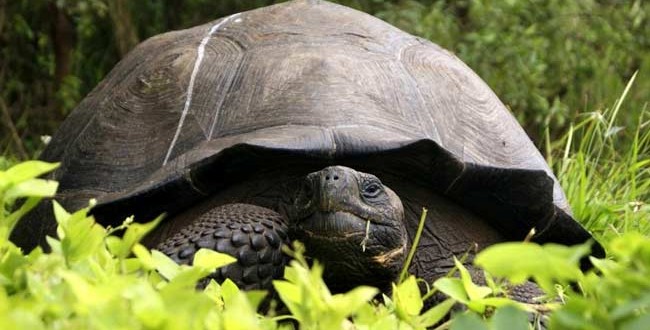Researchers say they have identified a new species of giant tortoise on the Galapagos Islands in the Pacific.
The discovery of the new species, detailed in a study reported (Oct. 21) in the journal “PLOS ONE,” is likely to help focus attention on the newly named Eastern Santa Cruz Tortoise (Chelonoidis donfaustoi), said Dr. James Gibbs, a team member and conservation biologist at the SUNY College of Environmental Science and Forestry in Syracuse, New York. Gibbs’ work on this discovery and others has been done in collaboration with the Galapagos National Park Service, Yale University and the Galapagos Conservancy.
“This is a small and isolated group of tortoises that never attracted much attention from biologists previously,” said Gibbs, who also participated in the first research expeditions to explore the new species’ range. “But we now know that they are as distinct as any species of tortoise in the archipelago.
Their discovery and formal description will help these tortoises receive the scientific and management attention they need to fully recover.”
The discovery also calls attention to a longtime Galapagos National Park ranger who spent decades developing methods still used today for breeding endangered tortoises. His name is Fausto Llerena Sánchez, known to his friends and colleagues as Don Fausto. The new species’ Latin name was chosen in his honor.
Don Fausto dedicated 43 years (1971-2014) to giant tortoise conservation as a park ranger for the Galapagos National Park Directorate. He was the primary caretaker at the Tortoise Breeding and Rearing Center on Santa Cruz, which now bears his name. The restoration of several tortoise populations is due in part to Don Fausto’s dedication and efforts.
“It’s to honor Don Fausto for all his dedication and hard work,” Gibbs said. “He devoted his life to saving many critically endangered tortoises through captive breeding. It isn’t easy to breed tortoises in captivity. He didn’t have many resources or much guidance. He figured it out through patient observation, great creativity and intelligence, and tremendous resourcefulness.”
Gibbs said Don Fausto successfully bred tortoises in Galapagos while many of the best zoos around the world have failed in their efforts to do so. “I recall many times seeing Don Fausto early on a Sunday morning, when most everybody else was still asleep, riding his bike to the captive rearing center to tend to the tortoises,” Gibbs said. “His dedication to his work has been inspirational.”
There are two populations of giant tortoises on the island: a large population on the west side in an area known as the “Reserve” and another on the lower eastern slopes around a hill named “Cerro Fatal.” Until the recent discovery, researchers believed that these populations belonged to the same species of tortoise. Genetic and morphological analyses conducted by an international group led by Dr. Gisella Caccone of Yale University have now clearly identified the two populations as separate species: the Western Santa Cruz Tortoise (Chelonoidis porteri) and the new Eastern Santa Cruz Tortoise.
Giant tortoises have been among the most devastated of all Galapagos creatures because of human exploitation, introduced species and habitat degradation. The Giant Tortoise Restoration Initiative is a collaborative project of the Galapagos National Park Directorate, Galapagos Conservancy, Caccone’s group at Yale University and others that works toward the long-term restoration of all Galapagos tortoise populations.
Agencies/Canadajournal
 Canada Journal – News of the World Articles and videos to bring you the biggest Canadian news stories from across the country every day
Canada Journal – News of the World Articles and videos to bring you the biggest Canadian news stories from across the country every day



